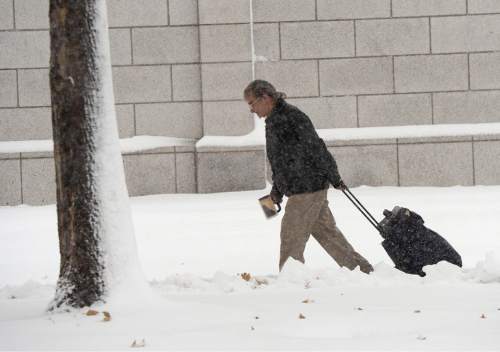This is an archived article that was published on sltrib.com in 2015, and information in the article may be outdated. It is provided only for personal research purposes and may not be reprinted.
Sure, dealing with a driveway or sidewalk buried in snow is a pain. But not being aware of local snow removal ordinances could bring that aching, empty feeling to your wallet.
Nichol Bourdeaux, a spokeswoman for the Salt Lake City Mayor's Office, warned on Monday that property owners risk hefty fines if they don't clear snow and ice from city sidewalks in a timely manner. That means a minimum clearance of 42 inches in width on wide sidewalks, or if the sidewalk is narrower, at least the complete width of the concrete.
Under city code, snow and ice have to be cleared from the corners to the curb ramps within 24 hours from the end of a storm; ice must be removed to the bare pavement, or at least be made as level as possible and treated with ice melt, sand or similar traction substances.
However, don't just shovel all that snow and ice into the street; that could get you in trouble, too. Property owners are also reminded that they are responsible for removing snow from and around fire hydrants, benches and vehicles.
Salt Lake City Civil Enforcement officials will give each property one warning per winter season. Subsequent violations could bring fines of $50 to $200, depending on the size of the property and how long sidewalks have been left uncleared.
Residents are asked to help the city enforce the snow removal laws by reporting infractions to 801-535-7225.
Bourdeaux said the Mayor's Office urges neighbors to aid the elderly and disabled with their snow removal obligations.
The city's fleet of 45 trucks and plows, meanwhile, are busy removing snow from 1,858 lane miles of roadway, with crews driving an average of 80,000 miles — the equivalent of driving the circumference of the earth 3.2 times — every winter season.
City road crews also use up to 20,000 tons of salt each year to keep the roads safe.
Snow removal is done according to priority: Priority 1 includes arterials that provide access to key locations and services such as fire stations, hospitals and schools; Priority 2 roads are local collectors that feed into arterials; and Priority 3 roads are residential.
Motorists are asked to park off the streets during and after snowstorms to aid plowing, and to stay back from plows and salt trucks at least 200 feet while driving.
Another tip: Don't leave your car to warm up unattended during winter months. The Salt Lake City Police Department processes an estimated 300 vehicle theft reports every year where thieves simply hop behind the wheel and drive off.
For more information on Salt Lake City's snow-related ordinances, visit http://www.slcgov.com/snow.
Twitter: @remims





